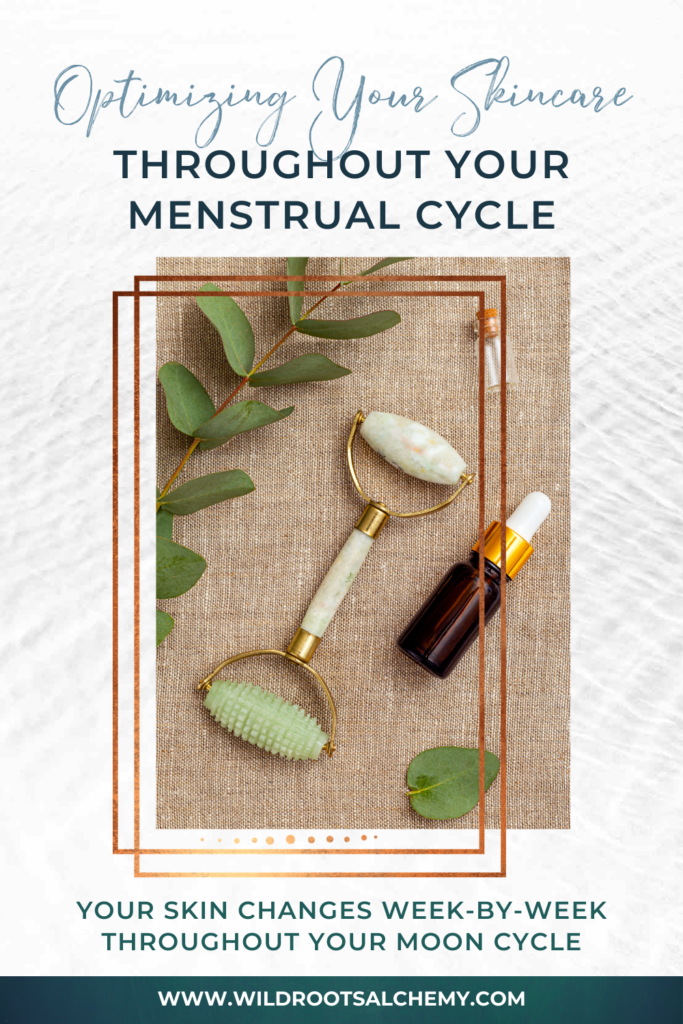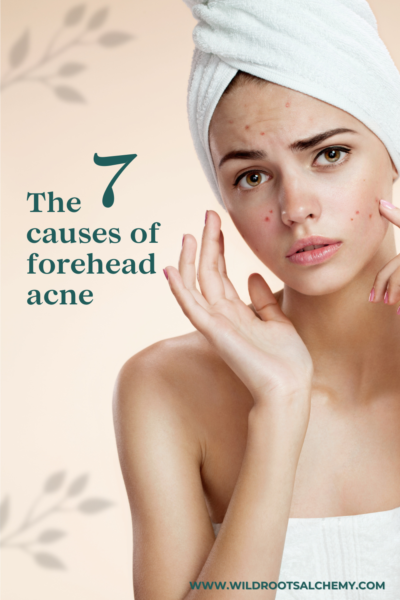
Did you know that your skin changes depending on the time of day, time of the month, and time of year?
Your skin—and the rest of your body—follows Nature’s rhythms, including:
- a circadian rhythm (in alignment with rising and setting of the sun and your 24-hour sleep/wake cycle)
- a weekly rhythm (in alignment with your menstrual cycle)
- a seasonal rhythm (in alignment with the four seasons)
For this article, I’m going to break down how your skin changes throughout the month according to the four phases of your menstrual cycle.
As your hormones naturally shift throughout the month, they affect your skin in different ways. There are times in your cycle when your skin is more luminous and hydrated, and other times when it can be more prone to dryness, acne, and inflammation.
By understanding how your skin changes over the month, you can optimize your skincare to best support your skin’s tendencies and prevent blemishes or other skin issues that tend to pop up around specific times.
Let’s dive into how your hormones affect your skin throughout the month! (For a complete breakdown of what your hormones are up to week-by-week, see this post all about the four phases of your menstrual cycle.)
Week 1: Estrogen and progesterone are both at their lowest during your menses
Estrogen is the “plump-up-your-skin” hormone. It stimulates collagen and elastin production, and promotes moisture retention by boosting your hyaluronic acid levels.
When estrogen is low during the first week of your menstrual cycle, your skin will have a tendency to be dry and dull. Your skin barrier is more likely to be disrupted at this time, possibly leading to increased sensitivity and redness.
Since progesterone is responsible for elevating your basal body temperature and increasing circulation to your skin, low progesterone levels at the start of your cycle can also contribute to dry and dull skin due to the reduction in peripheral circulation.
How to support your skin this week:
- Keep your skin hydrated from the inside out and the outside in. Drink plenty of water and apply humectants to your skin after cleansing (like hyaluronic acid or aloe vera gel) to keep moisture locked in. (Juice Beauty’s Green Apple Brightening Essence contains both hyaluronic acid and aloe vera gel, and can help brighten your skin this week if it tends to look dull and dehydrated!)
- Use soothing topical skincare and avoid harsh ingredients like retinol and exfoliating products during this time.
- Facial dry skin brushing, facial massage, and gua sha can help increase circulation to your face, promoting more glow and less dullness.
Week 2: Estrogen rises and reaches its peak
With estrogen rising right before ovulation, your skin likely looks and feels its absolute BEST this week! This is because estrogen is helping your skin look more smooth, helps keep it hydrated, and reduces the appearance of fine lines and wrinkles.
Estrogen gives you a natural glow-up during your second week. Nature is wise like that: your body wants you to look and feel your best when you’re at the prime time for getting pregnant!
How to support your skin this week:
- Your skin will be able to better absorb and utilize active ingredients this week (like vitamin A and C, MSM, and niacinamide). (Juice Beauty’s Green Apply Age Defy Serum contains antioxidants like vitamin C that can help reduce inflammation and the appearance of hyperpigmentation and marks left behind by acne.)
- Gentle exfoliation can be helpful this week and should be well-tolerated.
Week 3: Progesterone rises and reaches its peak
Progesterone makes you feel calm, which can help with stress-related skin conditions (but your progesterone must be high enough and in optimal balance with your estrogen levels).
Progesterone affects androgen metabolism and can stimulate sebum production, making skin more oily this week. This can lead to premenstrual acne in those who are acne-prone, typically as you get closer to week 4.
Progesterone also causes you to be hungrier and crave more carbohydrates. If you find yourself eating lots of sugary snacks right before your menses, this can throw off your blood sugar balance, leading to premenstrual acne associated with blood sugar dysregulation.
How to support your skin this week:
- Stay hydrated to ensure that your skin doesn’t overproduce oil due to dehydration.
- Keep your blood sugar regulated as much as possible. This will support healthy hormone levels and help reduce androgenic sebum production.
- Gentle masks (i.e. clay, charcoal) can be used up to 2-3 times this week to help keep pores clear. Avoid masks that dry out your skin. (This Bamboo Pore Refining Mask contains charcoal and kaolin clay to decongest your pores, along with gently exfoliating polyhydroxy acids that help smoothe your skin.)
- Gentle exfoliating acids (AHAs/PHAs or BHAs if tolerated) can be used during this time to help with oily skin and to support skin barrier health. (I’ve seen great results with this Blemish Clearing Serum that contains salicylic acid from willow bark, green tea extract, and vitamins C and E.)
Week 4: Estrogen and progesterone levels fall right before your next menses and androgens have a free pass
Estrogen and progesterone both start to fall about a week after ovulation. Androgens (like testosterone) generally stay at the same level throughout your cycle.
With low estrogen and progesterone levels, androgens now have a chance to stimulate your androgen receptors and promote more sebum production. Unopposed androgen activity can occur if progesterone levels dip too low right before your period.
Premenstrual acne is most common this week if there are any imbalances in your sex hormones.
How to support your skin this week:
- Stay hydrated to ensure that your skin doesn’t overproduce oil due to dehydration and to alleviate dryness that may develop during your menses the next week.
- Keep your blood sugar regulated as much as possible. This will support healthy hormone levels and help reduce androgenic sebum production.
- Focus on skin barrier health to reduce inflammation and offset the effects of low estrogen levels. Some ingredients that help repair the skin barrier include linoleic acid-rich oils, ceramides, niacinamide, and hyaluronic acid. (Juice Beauty’s USDA Organic Treatment Oil contains oils high in linoleic acid and organic herbal extracts that can help repair the skin barrier.)
- Gentle exfoliating acids (AHAs/PHAs or BHAs if tolerated) can be used during this time to help with oily skin and to support skin barrier health. (I’ve seen great results with this Blemish Clearing Serum that contains salicylic acid from willow bark, green tea extract, and vitamins C and E.)
- Drinking a tea made with liver-supportive herbs (like this detox tea recipe found in my Jupiter Plant Medicine blog post) can help your liver better metabolize hormones and can alleviate acne breakouts before your period.
Start paying attention to how your skin changes during your menstrual cycle. When you begin to incorporate these tips to support your skin as it changes each week, your skin will respond by being less prone to breakouts and more radiant as time goes on!
Disclaimer: Some of the links to products in this article are affiliate links. I make a small commission off of the sale at no additional cost to you. Thank you for helping to support my small business!





